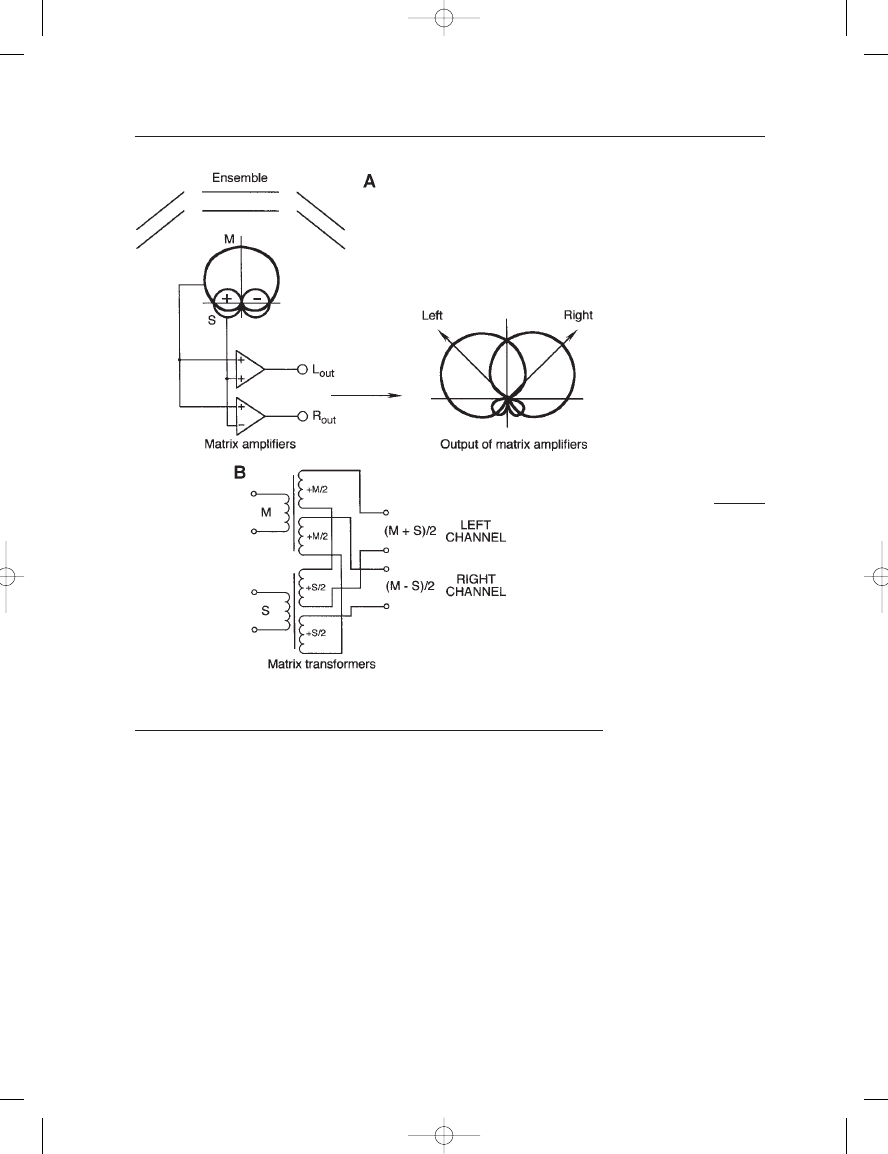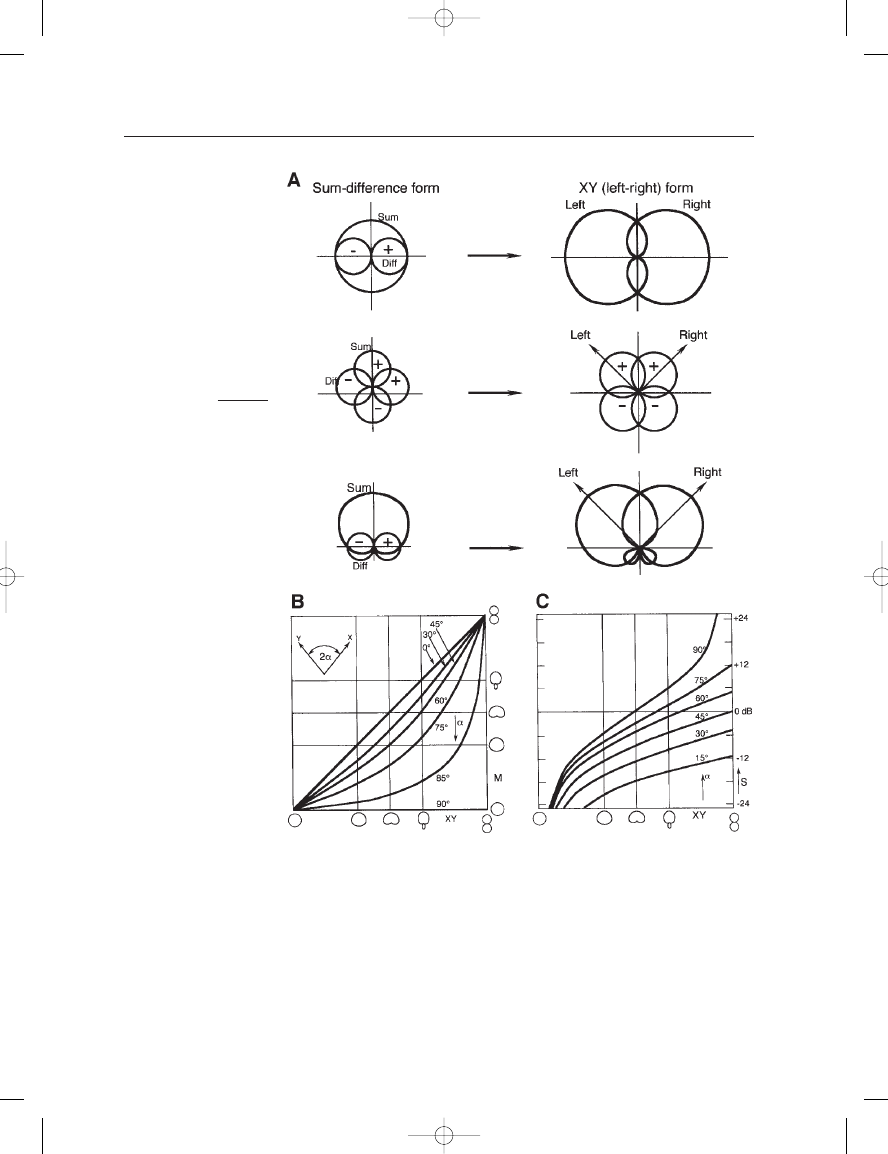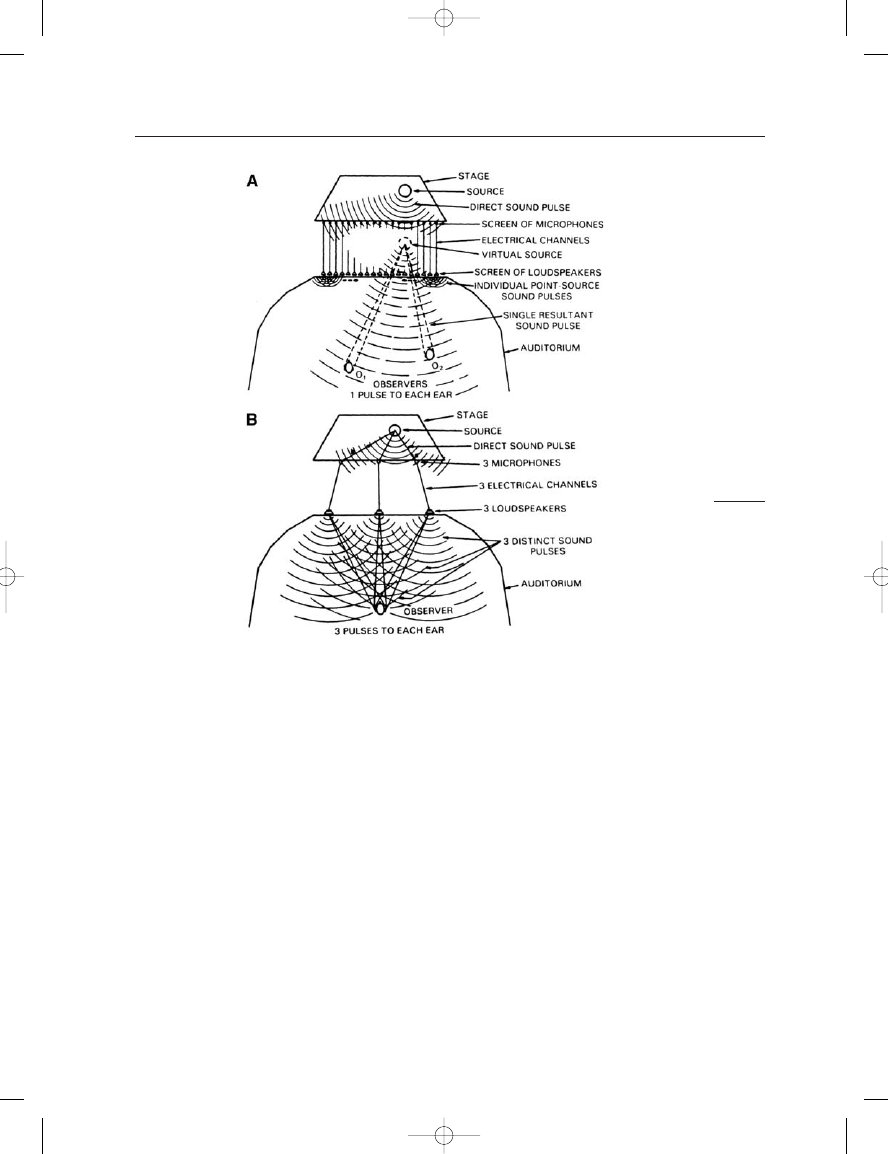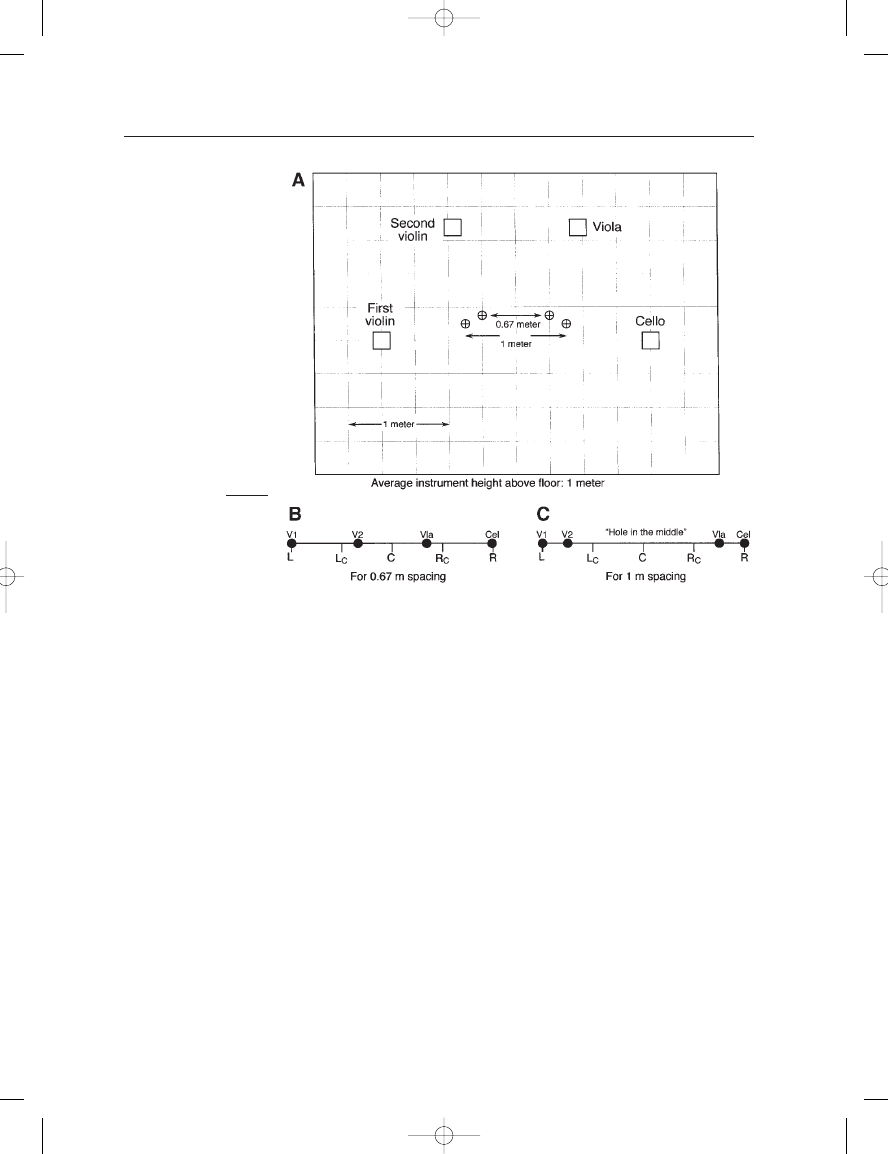ВУЗ: Казахская Национальная Академия Искусств им. Т. Жургенова
Категория: Книга
Дисциплина: Не указана
Добавлен: 03.02.2019
Просмотров: 17302
Скачиваний: 51

11: Basic Stereophonic Recording Techniques
173
its concomitant noise. Figure 11–6B and D shows the above two orien-
tations as they appear in the Franssen localization analysis.
In summary:
1. Crossed cardioid performance produces a center-oriented stereo
stage and, as such, may be a useful adjunct in studio pickup.
2. It results in wider imaging when the splay angle is increased.
3. It has excellent monophonic compatibility (left-plus-right), due to
the absence of antiphase components in the two signals.
4. Splayed supercardioids or hypercardioids are probably the most
useful, offering a good compromise between wide-stage pickup and
direct-to-reverberant balance.
A VARIATION ON X-Y TECHNIQUES:
MID-SIDE (M-S) PICKUP
Figure 11–7A shows a typical M-S recording setup. A cardioid pattern
(the M component) is forward facing, and a figure-8 pattern (the S com-
ponent) is side facing. Both M and S components are often recorded sep-
arately and are combined in a matrix (sum-difference) network as shown
to produce resultant left and right pickup patterns. An alternate matrix
transformer circuit is shown at B.
The system offers excellent monophonic compatibility and consider-
able postproduction flexibility. For example, the S component can be
reduced to produce a narrowing of the resultant array. Alternatively, the
S component can be increased to produce a wider resultant array.
Primarily as a result of this degree of postproduction flexibility, M-S
pickup has always enjoyed great favor with broadcast engineers, who
have to deal with concerns of FM and television mono and stereo com-
patibility in a wide marketplace.
EQUIVALENCE OF MS AND XY
Any XY pair can be converted into an equivalent MS pair, and vice versa.
Examples of this are shown in the data of Figure 11–8. The charts shown
at B and C can be used to define the MS form for any given XY pair.
While a cardioid pattern is normally used for the M component, it is
not essential; omnidirectional or hypercardioid patterns can be used as
well if the resultant left and right patterns and their angular orientation
fit the technical needs of the engineer. Those readers who wish to study
M-S recording in detail are referred to the work of Hibbing (1989) and
Streicher and Dooley (1982, 2002).
In summary, M-S performance:
1. Has excellent stereo-to-mono compatibility for broadcasting.
2. Has flexibility in postproduction remixing.
3. Is easy to implement in the field.
Earg_11.qxd 14/9/04 2:50 PM Page 173

THE MICROPHONE BOOK
174
SPACED MICROPHONE RECORDING TECHNIQUES
The beginnings of stereo recording with spaced microphones go back to
the experiments carried out by Bell Telephone Laboratories (Steinberg
and Snow, 1934) during the 1930s. Snow (1953) describes a wall of
microphones, each communicating with a matching loudspeaker in a dif-
ferent space, as shown in Figure 11–9A. As a practical matter this array
was reduced to the three-microphone/loudspeaker array shown at B.
Later, this three-channel array gave way to an arrangement in which the
center microphone was bridged (center-panned) between the left and
right channels.
There is a strong tradition of using spaced omnidirectional micro-
phones for stereo recording, especially for smaller musical forms, such as
chamber music and solo piano. In Figure 11–3 we observed the stereo
stage as recreated by a single pair of omnidirectional microphones sepa-
rated by about 0.6 m (2 ft). When such a pair is in proximity to a small
group of players, then both amplitude cues and time cues can be useful
FIGURE 11–7
M-S system: a front-
facing cardioid and
side-facing figure-8, when
mixed as shown, are
equivalent to a pair of
splayed cardioid
microphones (A); alternate
method of achieving sum
and difference outputs
using transformers (B).
Earg_11.qxd 14/9/04 2:50 PM Page 174

11: Basic Stereophonic Recording Techniques
175
in defining the reproduced stereo stage. The images so produced may
not have the localization precision or specificity of those produced by a
coincident pair, and many people, engineers as well as musicians, often
prefer the so-called “soft edged” quality of these recordings. The anal-
ogy of slightly blurred optical imaging is quite apt.
Actually, there is no reason why spaced cardioids should not be
used – specially in large reverberant spaces. Traditionally, however, most
recording engineers who prefer the imaging qualities of spaced micro-
phones tend to favor omnidirectional models or subcardioids.
FIGURE 11–8
Several MS forms and their
equivalent XY forms (A);
conversion from XY to MS
(B and C); example: let an
XY pair consist of a two
supercardioids splayed at
an angle of 120
(2); from
B, locate the supercardioid
symbol and the right axis
and move to the left unto
the 60
curve is intersected;
then, read downward to
the horizontal axis and
note that the required M
directivity pattern will be
almost halfway between
supercardioid and figure-8;
then, going to the same
position on the horizontal
axis at (C), move upward
until the 60
curve is
intersected; finally, move to
the right axis and note that
the S level will have to be
raised about 2 dB relative
to the M level. (Data at B
and C courtesy of
Sennheiser.)
Earg_11.qxd 14/9/04 2:50 PM Page 175

THE MICROPHONE BOOK
176
If two omnidirectional microphones are spaced apart more than
about 1 m (3.3 ft), there may be a “hole in the middle” of the reproduced
sound stage. This occurs because of reduced signal correlation between
the two microphone transmission channels, and hence very little that the
ears can lock onto to form center-oriented phantom images. A practical
example of a two-microphone setup is shown in Figure 11–10A. Here,
the performers in a string quartet are arrayed left to right, and the
Franssen analysis of stereo localization is shown at B with a 0.67 meter
microphone spacing. If the microphone spacing is increased to, say,
1 meter, the Franssen analysis of localization gives the results shown in
Figure 11–10C. Here, the hole in the middle becomes quite evident.
For large groups such as an orchestra, it is essential that there be a
center microphone panned equally between the two stereo channels.
When this is done, the hole in the middle is effectively filled in, and the
listener senses a continuum of sound from left to right, albeit with some
loss of image specificity. Another important characteristic of such wide
microphone spacing is the generation of added early time cues. As an
example, consider a left-center-right microphone array spanning a total
width of about 8 m (25 ft). A sound source on-stage fairly close to the
right microphone will be heard first in the right loudspeaker, followed
FIGURE 11–9
Spaced microphones; a
wall of microphones and
loudspeakers (A); three
microphones and three
loudspeakers (B). (Figure
courtesy of the Society of
Motion Picture and
Television Engineers.)
Earg_11.qxd 14/9/04 2:50 PM Page 176

11: Basic Stereophonic Recording Techniques
177
closely by a center phantom signal delayed approximately 12 ms and a
later signal at the left loudspeaker delayed a further 12 ms. These two
delayed signals will be at a reduced level, and they will effectively simu-
late early acoustical reflections in the recording space itself, as shown in
Figure 11–11A. Their effect on the subjective impression of music may
be seen in the data shown in Figure 11–11B (Barron, 1971), where they
may influence the perception of tone coloration.
A typical large ensemble may be recorded as shown in Figure 11–12.
The proportions are those the author has found to work in most
instances. In normal acoustical spaces, omnidirectional microphones will
work well, but in rooms that tend to be fairly live, subcardioids may
work better because of their back rejection of about 3 dB. The level set-
ting of the center microphone is critical; it should be at least about 4 dB
lower in level with respect to the left and right microphones and should
be just sufficient to avoid the sense of a hole in the middle. Any greater
level of the center-panned signal is apt to make the stereo stage appear
too mono-heavy.
It is worth mentioning that most American symphonic recordings
made during the decades of the fifties and sixties were made basically in
this manner. These recordings have always been present in commercial
disc libraries, and they are as highly regarded today as they were in their
heyday.
FIGURE 11–10
Two spaced omnis with a
string quartet (A); Franssen
analysis for 0.67 m spacing
(B); Franssen analysis for
1 m spacing (C).
Earg_11.qxd 14/9/04 2:50 PM Page 177